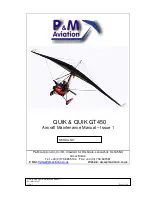
11
5. LOSING HEIGHT
The knowledge of the different descent techniques is an important
resource to use in certain situations. The most adequate descent method
will depend on the particular situation.
We recommend that you learn to use these maneuvers under the tuition
of a competent school.
5.1 EARS
Big ears is a moderate descent technique, achieving about –3 or –4 m/s
and a reduction in ground speed of between 3 and 5 km/h. Effective
piloting then becomes limited. The angle of incidence and the surface
wing load also increases. Push on the accelerator to restore the wing’s
horizontal speed and the angle of incidence.
To activate big ears take the outer line 3A2 on each A risers and
simultaneously, smoothly pull them outward and downward. The wingtips
will fold in. Let go of the lines and the big ears will re-inflate automatically.
If they do not re-inflate, gently pull on one of the brake lines and then on
the opposite one. We recommend that you re-inflate asymmetrically, not
to alter the angle of incidence, more so if you are flying near the ground
or flying in turbulence.
5.2 3B2 TECHNIQUE
On the new generation paragliders the application of big ears can create
a high degree of trailing turbulence which in turn creates a significant
loss of airspeed. When big ears are applied to high aspect ratio wings
the ears tend to “flap” which also adds to the amount of unwanted
turbulence.
This new rapid descent technique was first discovered by our Niviuk
team Pilots in 2009 while flying a competition prototype wing, which
because of its line plan and high aspect ratio would not allow big ears
to be applied. In fact big ears on wings with a profile of 2 lines can often
prove difficult.
For all these reasons, we advise the use of the 3B2 line descent
technique. This technique ensures a rapid descent is achieved whilst
forward wing speed is maintained and so the risk of a deep stall is
eliminated.
HOW?
Locate the 3B2 on your risers and as you would when applying big ears
simply pull down firmly and smoothly until you see both wingtips drop
back slightly. The forward speed of the glider speed will then reduce
slightly, quickly stabilize and then increase. You will then experience
a fall rate of around 5-6m/s. Controlled turning of the wing can easily
be maintained by weight shifting the harness, exactly the same as you
would with big ears. We recommend the application of the speed bar
whilst using this technique. To exit the maneuver release the lines as you
would with big ears, control the pitch and the wing will quickly adopt
normal flight.
This new technique allows a comfortable and controllable rapid descent
without the risk of experiencing a “cravat” or “deep stall”.
We advise you to first try this technique in smooth conditions with
sufficient altitude above appropriate terrain.
5.3 B-LINE STALL
When you carry out this maneuver, the wing stops flying, it loses all
horizontal speed and you are not in control of the paraglider. The air
circulation over the profile is interrupted and the wing enters into a
situation similar to parachuting.
Summary of Contents for IKUMA 21
Page 1: ...USER S MANUAL IKUMA...
Page 17: ...10 3 RISERS ARRANGEMENT 17...











































